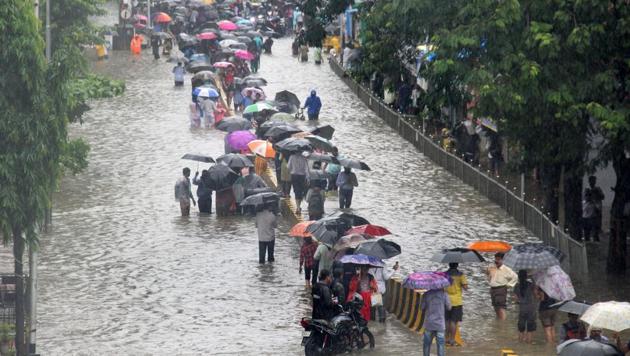Mumbai drowning under haphazard planning, changing weather patterns
Experts say road works and other projects are lowering Mumbai’s ability to drain rainwater.
On June 21, the Brihanmumbai Municipal Corporation (BMC) assured the Bombay high court that it was prepared to “tackle all natural calamities” this monsoon. It had mapped 186 flooding spots, installed water suction pumps in areas prone to waterlogging and installed special safety grilles on manholes. On paper, the civic body was ready for the annual rainy season – until the torrential rainfall of July struck the city.

On Tuesday, Mumbai surpassed more than 65% of its average annual rainfall in just the first month of the monsoon and the city’s infrastructure has struggled to cope with the downpour. In addition to places like Hindmata, which are low-lying and known to be prone to flooding, Tuesday saw waterlogging in Goregaon, Chembur and Mankhurd. In Vasai, the National Disaster Response Force had to be deployed. Stretches of the local train network’s tracks were submerged. Flights were delayed and traffic was disrupted all over the city.
Pockmarked by Metro and Monorail construction sites as well as road works and other projects, Mumbai is drowning under haphazard urban planning and changing weather patterns. The concretization of the city is considered to be a sign of development by many, but experts warn that these projects are significantly lowering Mumbai’s ability to drain rainwater.
City-based architect Roshni Udyavar Yehuda said the rapid concretization meant shrinking surface area in Mumbai, which makes the city becoming more vulnerable to waterlogging. “In new projects, there is next to no open space that will allow water to seep into the ground,” said Yehuda.
Studies conducted by the Indian Institutes of Technology at Mumbai (IIT-B) and Gandhinagar (IIT-Gn) suggest that considering the rainfall projections for Mumbai, the city will have to increase the carrying capacity of its storm water drains. “There’s been rapid urban growth, but the drainage system is based on past rainfall records and does not take into account the changing nature and characteristic of rainfall that has led to an underestimation of the old design,” said Vimal Mishra, associate professor at IIT-Gn.
Meteorological data suggests Mumbai is likely to face more intense flooding in the near future. In 2017, the Indian Institute of Tropical Meteorology in Pune found that across India, there had been a threefold rise in rainfall extremes during the monsoon over the past three years. IIT-B studied rainfall data for Colaba (1901-2008) and Santacruz (1951-2008) and found there was now one percent chance that Colaba could record 164mm of rain in an hour.
One percent may sound like a low probability, but on July 26, 2005, Mumbai witnessed 190mm of rainfall per hour.
After the 2005 deluge, the Brihanmumbai storm water disposal system (Brimstowad) project was put in place. The plan involved eight pumping stations and 58 projects to improve the city’s century-old pipelines. Fewer than half of these projects have been completed and Joshi said that even Brimstowad is not equipped to deal with the rainfall projections suggested by the data. “The existing drainage system should have been designed considering changes in rainfall patters based on future climate projections,” said Pankaj Joshi, director of Urban Design and Research Institute (UDRI).
Extreme rainfall and drainage are problems that are likely to become more severe in the near future. “The new Development Plan allows open space to be available on top of a podium,” said Joshi. “Essentially, these buildings are occupying the surface with construction and going underground to cover the entire plot area with multi-storied basements, taking away the permeability of the ground. Where will the water go?”
It doesn’t help that different government departments seem to be undercutting each other instead of working in tandem. “In a city like Mumbai, you have the railways, the BMC, the Mumbai Metropolitan Region Development Authority, the Mumbai Metro Rail Corporation, the Public Works Department, and all are at loggerheads about jurisdiction, which leads to carelessness on behalf of all parties involved. Each one believes the other will do the job,” said Nandkumar Salvi, former chief engineer of BMC’s SWD department.
In the BMC, for example, while the department of storm water drains (SWD) works hard to clean drains, nullahs and water laterals to maintain the drainage system, the department of building proposals sanctions projects without adhering to urban planning standards. Excessive and unchecked laying of utility in storm water drain culverts – such as telephone cables and gas pipelines – can choke drains, said Salvi. There is also the problem of ineffective solid waste management, which chokes storm water drains.
Researchers said bad urban planning has helped give rise to extreme rain that is not uniform across the city. “If there are a series of buildings with a road running in the middle, wind with all its moisture narrows down and follows the path of the road. With buildings acting as obstacles, the wind profile and flow gets disturbed, the atmosphere becomes unstable leading to more rainfall over a specific location,” said Subimal Ghosh of IIT-B’s civil engineering department.
“We are in a situation when we won’t witness urban flooding just once or twice during the entire monsoon season, but every time it rains,” warned Mishra.
Meanwhile, the India Meteorological Department (IMD) has forecast heavy to very heavy rain in parts of Mumbai and its suburbs till Friday.
Stay updated with all the Breaking News and Latest News from Mumbai. Click here for comprehensive coverage of top Cities including Bengaluru, Delhi, Hyderabad, and more across India along with Stay informed on the latest happenings in World News.
Stay updated with all the Breaking News and Latest News from Mumbai. Click here for comprehensive coverage of top Cities including Bengaluru, Delhi, Hyderabad, and more across India along with Stay informed on the latest happenings in World News.






